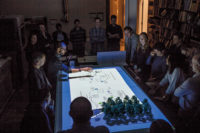New Books Explore Definition of Brutalism

Finding Brutalism: A Photographic Survey of Post-War British Architecture, edited by Simon Phipps, Hilar Stadler, and Andreas Hertach. University of Chicago Press and Park Books, 256 pages, $39.

SOS Brutalism: A Global Survey, edited by Oliver Elser, Philip Kurz, and Peter Cachola Schmal. University of Chicago Press and Park Books (two volumes), 716 pages, $69.


Perhaps the aesthetic equivalent of licorice, Brutalism is revered and reviled with equal vehemence. Proponents find appeal in its rough, usually concrete, textural finishes, while detractors have called for the removal of what they consider to be ugly, stained, bunkerlike structures. Brutalist buildings have found themselves in precarious preservation territory of late; many, some over 60 years old, have fallen into disrepair, yet are ineligible for landmark status, resulting in emotionally devastating demolitions such as Alison and Peter Smithson’s Robin Hood Gardens’ in London, built in 1972 and torn down in 2017. Supporters fear additional losses and want to document these buildings before they disappear—therefore spurring a spate of books and conferences.
Brutalism’s substantive meaning has conflicting origin myths. In the UK, the Smithsons gave the term “New Brutalism” to a warehouse-vernacular aesthetic with an emphasis on as-found materiality, usually brick and concrete. In 1955, critic Reyner Banham cited the Smithsons’ work as crucial to this movement; his 1966 book, The New Brutalism: Ethic or Aesthetic?, further disseminated the term. Le Corbusier’s use of béton brut—exemplified by his Unité d’Habitation social housing projects of the 1950s, along with the architecture of Paul Rudolph and others in the United States in the 1960s—helped shift the defining characteristic of Brutalism from raw materiality to raw concrete, the literal translation of the French term.
SOS Brutalism presents the theoretical issues behind the term in a two-volume set covering the origins, current state, and potential future of Brutalism. The eponymous first volume is a worldwide compendium—based on the website #SOSBrutalism—that has more than 1,100 Brutalist buildings in its database. This effort is filled with case studies and examples of structures of varying status: still in use (such as Minoru Yamasaki’s Shiraz University in Iran), heritage-protected, under threat of elimination, or demolished. Chapter introductions show the divergent attitudes to each region’s embrace of the movement. The companion volume, Brutalism: Contributions to the International Symposium in Berlin 2012, comprises 17 lectures in which authors investigate theories and regions where Brutalism was practiced according to country-specific interpretations.
In Finding Brutalism, Simon Phipps lets a rich assortment of his black-and-white photographs do the talking, save for a trio of essays at the back. But that’s precisely the point: each of his images is a 1,000-word composition on material, scale, or form, and Phipps is a master storyteller in this medium without “the distractions and extraneous detail of color,” so, as he writes, “the form and structure and surface textures [can] be amplified by the action of light and shadow.” His approach returns to the origins: “The biggest misunderstanding about Brutalism is that it is all about concrete—not only concrete, but massively formed concrete. The essence of Brutalism for me is material ‘as found.’ ”
The SOS book calls for recognition and understanding of buildings that contribute to a global heritage, which is being lost as individual examples fall into disrepair and sometimes demise. Finding Brutalism echoes this call through its meticulous cataloguing of specimens that continue to erode. Both books serve as weighty reminders of our collective legacy, preserved in print if, in the event, they fail to survive as architecture.






